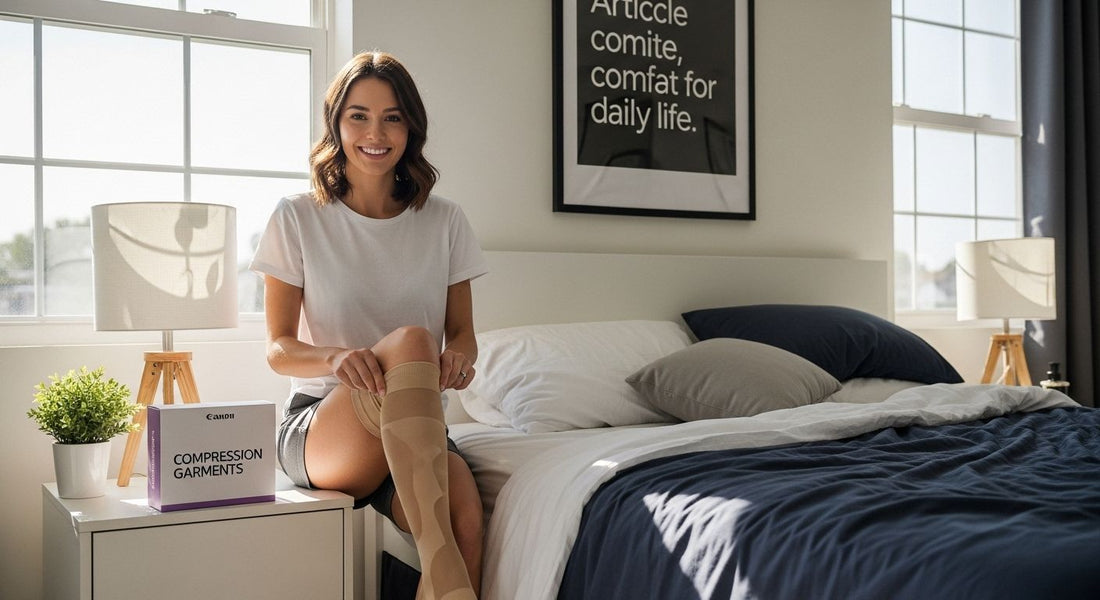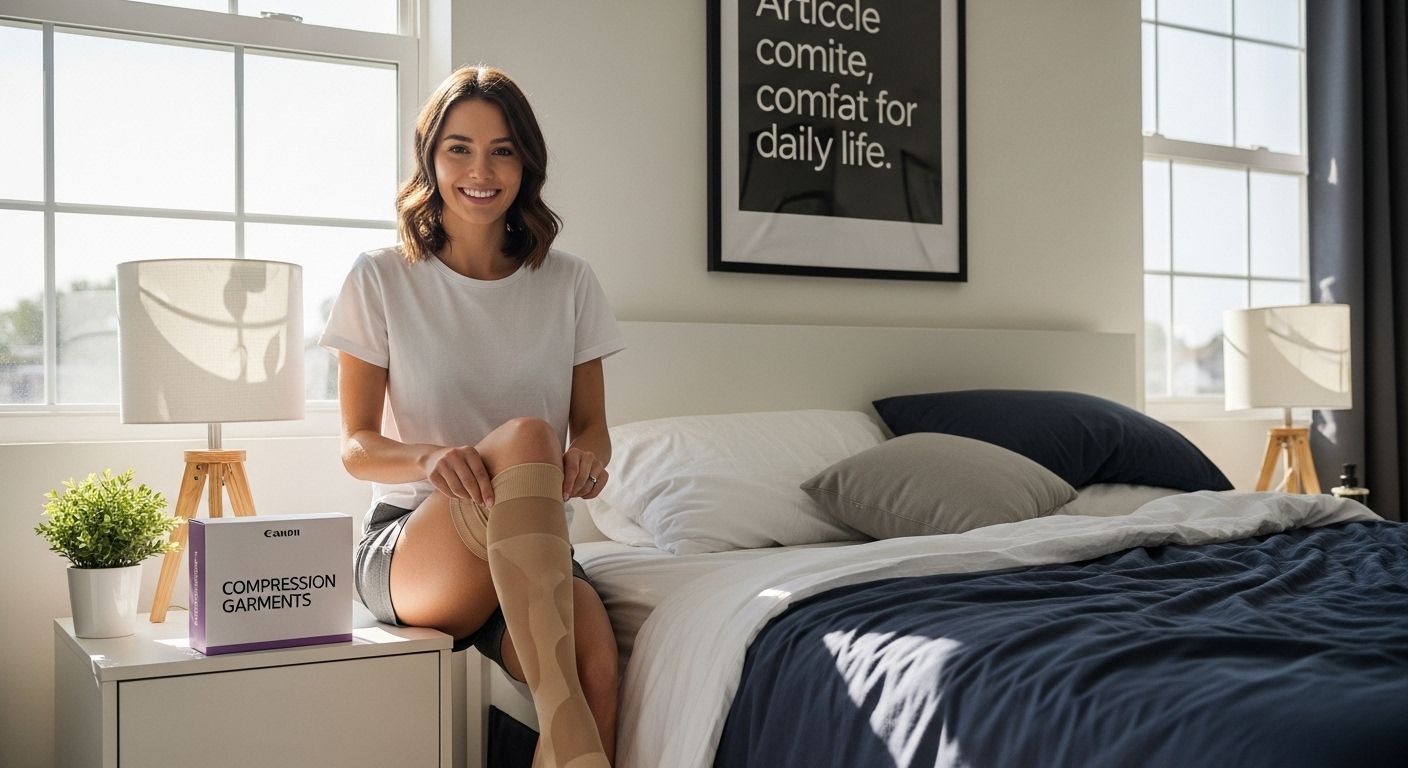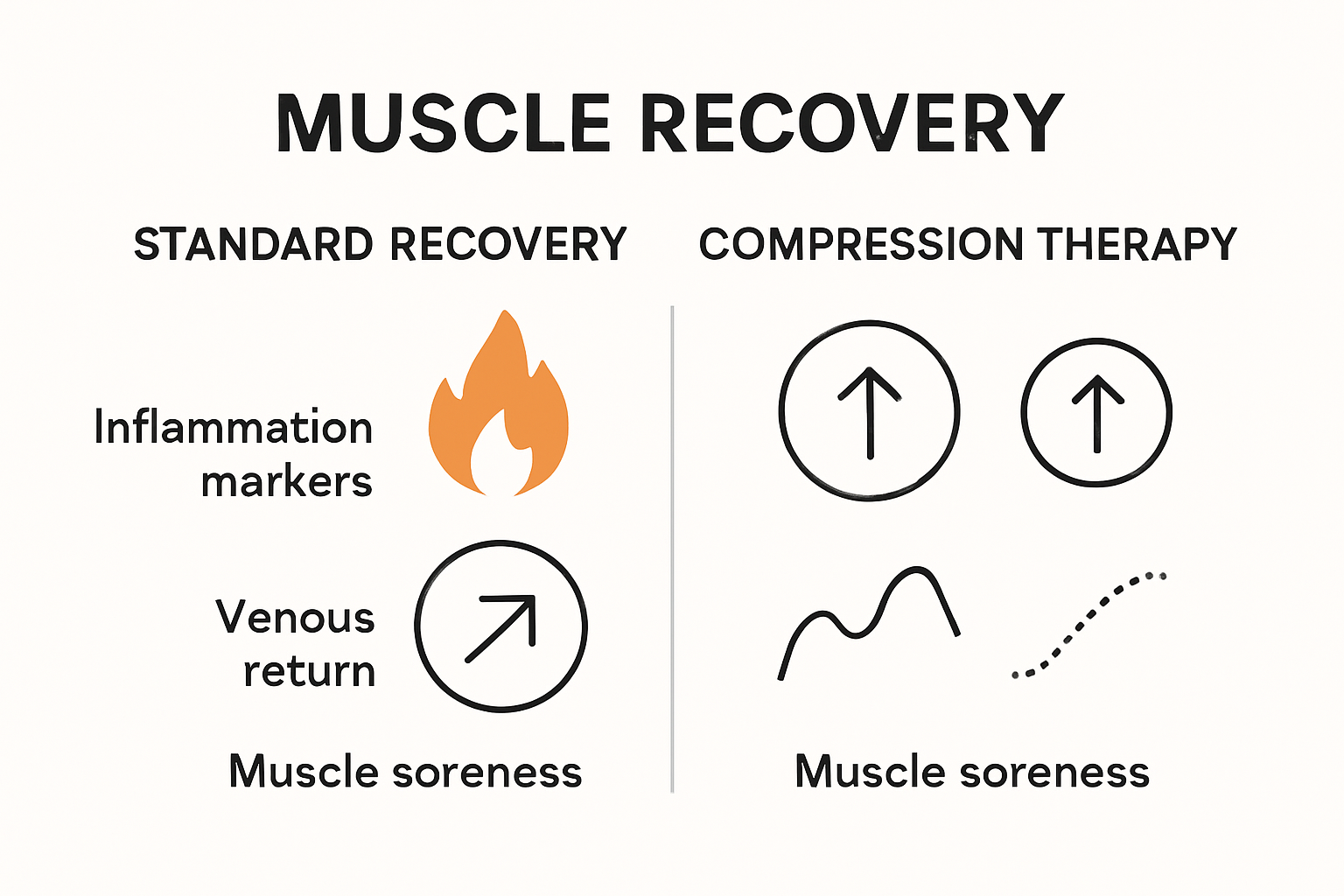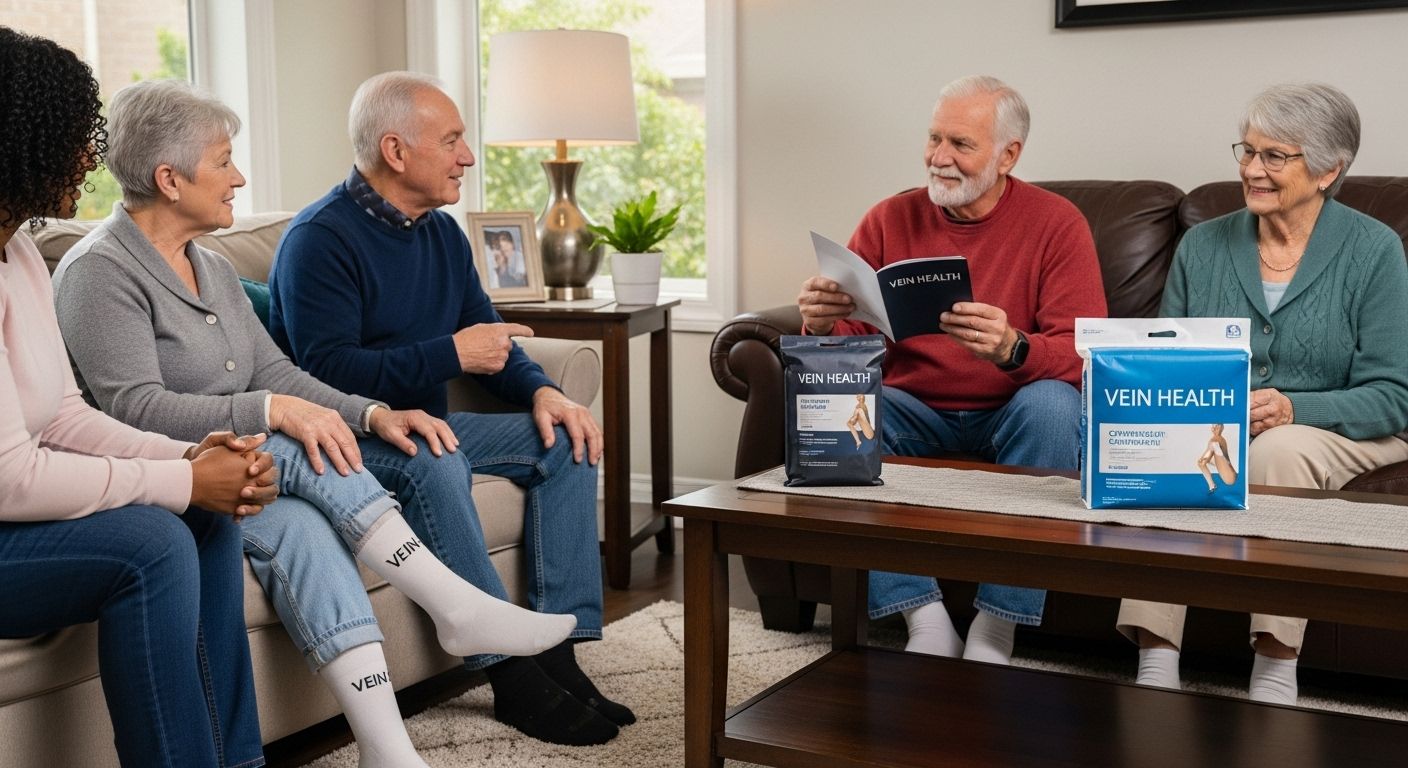
Top Compression Garments Benefits for Vein Health and Recovery 2025
Share

Compression garments are everywhere and you might think they are just for runners or for people recovering from surgery. That sounds logical, right? Turns out, modern compression garments can reduce swelling and discomfort for over 75 percent of users with chronic vein issues, making them a daily comfort hack for anyone who spends long hours on their feet or sitting at a desk. The real shock is how far their benefits actually reach beyond medical settings into everyday lifestyle and recovery.
Table of Contents
- How Compression Garments Support Vein Health
- Compression Garments for Swelling and Comfort
- Boosting Recovery with Compression Therapy
- Choosing the Right Compression Garment for You
Quick Summary
| Takeaway | Explanation |
|---|---|
| Compression garments enhance blood circulation. | These garments utilize pressure gradients to promote venous return from the legs to the heart. |
| They prevent venous disorders and aid healing. | Compression garments help prevent blood pooling and support the healing of venous conditions like varicose veins. |
| Compression therapy reduces swelling effectively. | By applying consistent pressure, these garments facilitate fluid movement, reducing tissue swelling and discomfort. |
| Choosing the right compression level is crucial. | The effectiveness relies on personal health needs, with different pressure levels tailored to specific medical conditions. |
| Comfort and style are now prioritized in designs. | Modern compression garments come in various styles and materials, ensuring users can maintain personal aesthetics while addressing health issues. |
How Compression Garments Support Vein Health
Compression garments play a crucial role in supporting vein health by leveraging precise mechanical pressure to improve circulatory function and prevent venous complications. These specialized medical garments work through a targeted approach that addresses multiple aspects of circulatory wellness.
Enhancing Blood Circulation and Venous Return
Compression garments create strategic pressure gradients that actively support blood flow from the extremities back to the heart. Discover how compression therapy works to understand the mechanics behind this critical health intervention. According to the Cleveland Clinic, compression therapy significantly increases blood circulation in lower legs, ankles, and feet, effectively treating conditions associated with poor circulation.
The graduated compression design is particularly innovative. Garments apply maximum pressure at the ankle and gradually decrease pressure as they move up the leg. This design creates a natural pumping mechanism that helps push blood upward against gravity, preventing blood pooling and reducing the risk of venous disorders. Athletes and medical professionals alike recognize this mechanism as a powerful tool for maintaining optimal circulatory health.
Preventing Venous Complications and Supporting Healing
Compression garments serve as a preventative and therapeutic solution for various venous conditions. Stanford Health Care notes that these garments effectively squeeze veins to prevent blood from flowing backward, which is crucial in healing skin sores and preventing additional complications.
Research published in sports medicine journals demonstrates the broader applications of compression technology. A 2021 study found that compression garments not only improve venous return but also enhance muscle blood flow, indicating their potential benefits extend beyond simple circulatory support.
For individuals with chronic venous insufficiency, varicose veins, or those at risk of deep vein thrombosis, compression garments offer a non-invasive method of managing circulatory health. By maintaining consistent pressure and supporting vein function, these garments help reduce swelling, minimize the risk of blood clots, and promote overall vascular wellness.
The effectiveness of compression garments relies on proper fit and graduated pressure levels. Medical-grade compression stockings typically range from 15-40 mmHg, with higher pressure levels providing more intensive therapeutic support. Patients should consult healthcare professionals to determine the most appropriate compression level for their specific medical needs.
Understanding the science behind compression garments reveals their remarkable potential in supporting vein health. From athletes seeking performance optimization to patients managing chronic circulatory conditions, these garments represent a sophisticated approach to maintaining and improving vascular function.
To help you understand how compression garments serve different needs based on medical guidance and pressure levels, the following table summarizes the main compression categories and their associated uses.
| Compression Level (mmHg) | Category | Typical Uses |
|---|---|---|
| <20 | Low | Mild symptoms, daily prevention, general discomfort |
| 20–30 | Medium | Varicose veins, mild edema, moderate chronic venous insufficiency |
| 30–40 | High | Severe venous insufficiency, healing venous ulcers, post-surgery |
Compression Garments for Swelling and Comfort
Compression garments provide a sophisticated solution for managing swelling and enhancing personal comfort across various health conditions and lifestyle scenarios. These specialized garments offer more than simple pressure application they represent a targeted approach to managing bodily inflammation and promoting overall physical wellness.
Understanding Swelling Reduction Mechanisms
Swelling occurs when excess fluid accumulates in body tissues, causing discomfort and potential health complications. Learn about advanced compression techniques to understand how these garments combat fluid retention. According to the Cleveland Clinic, compression therapy effectively increases blood circulation and reduces swelling in lower extremities by creating consistent external pressure.
The graduated compression design plays a critical role in managing swelling. These garments apply maximum pressure at the ankle and gradually decrease pressure as they move up the leg. This strategic pressure gradient creates a natural pumping mechanism that encourages fluid movement, preventing stagnation and reducing inflammation. Medical professionals recommend this approach for patients experiencing edema, lymphatic disorders, and post surgical recovery.
Comfort and Lifestyle Benefits
Beyond medical applications, compression garments offer significant comfort advantages for diverse populations. The Venous Forum highlights that graduated compression stockings provide external support that reduces blood pooling in leg veins, helping individuals maintain comfort throughout daily activities.
Athletes, travelers, pregnant women, and professionals who stand for extended periods can particularly benefit from compression garments. These individuals often experience leg fatigue, swelling, and discomfort due to prolonged static positioning or repetitive movements. Compression garments offer a proactive solution by promoting circulation, reducing muscle vibration, and providing supportive muscle recovery.
People with certain medical conditions such as diabetes, venous insufficiency, and lymphedema find compression garments instrumental in managing daily discomfort. The garments help control swelling, prevent fluid accumulation, and provide a sense of physical support that enhances overall mobility and quality of life.
Choosing the right compression garment involves considering factors like pressure level, material composition, and individual health requirements. Medical grade compression stockings typically range from 15-40 mmHg, with specific pressure levels recommended based on individual health needs. Check out our comprehensive fitting guide to ensure optimal comfort and therapeutic effectiveness.
Modern compression garments have evolved beyond traditional medical appearances. Contemporary designs offer stylish options that seamlessly integrate with various wardrobes, allowing users to manage health concerns without compromising personal style. Breathable fabrics, moisture wicking properties, and ergonomic designs ensure that comfort remains paramount.
Understanding compression garments as more than mere medical accessories reveals their transformative potential. They represent an intelligent approach to managing physical comfort, supporting circulation, and enhancing overall well being across diverse lifestyles and health conditions.
Boosting Recovery with Compression Therapy
Compression therapy represents a sophisticated approach to accelerating recovery across multiple domains, from athletic performance to medical rehabilitation. By applying strategic external pressure, these innovative garments create a comprehensive recovery environment that supports the body’s natural healing mechanisms and enhances physiological restoration.
Athletic Performance and Post Exercise Recovery
Discover advanced recovery techniques for athletes that leverage compression technology. Athletes consistently experience significant benefits from compression therapy, with research demonstrating its remarkable potential in reducing muscle soreness and expediting recovery times. According to a comprehensive review published in WebMD, compression therapy gently squeezes muscles, which helps improve blood flow and accelerate the removal of metabolic waste products generated during intense physical activity.
The mechanism behind compression therapy’s effectiveness lies in its ability to enhance venous return and reduce muscle oscillation. By providing consistent external pressure, compression garments minimize muscle micro trauma and decrease inflammation markers. This process not only reduces recovery time but also helps prevent potential sports related injuries by supporting muscle stabilization and reducing unnecessary muscle movement during and after exercise.

Medical Rehabilitation and Healing Support
Beyond athletic applications, compression therapy plays a crucial role in medical rehabilitation contexts. National Institutes of Health research demonstrates that compression therapy can significantly improve healing rates for venous leg ulcers, reduce pain complaints, and decrease the risk of ulcer recurrence.
Patients recovering from surgical procedures, managing chronic venous disorders, or addressing lymphatic complications find substantial relief through targeted compression therapy. The graduated pressure design ensures consistent blood circulation, which is instrumental in promoting tissue healing, reducing swelling, and preventing potential complications associated with reduced mobility.
Healthcare professionals increasingly recommend compression garments as a non invasive intervention for various recovery scenarios. The therapy works by creating a gentle yet consistent external pressure gradient that supports the body’s natural circulatory and healing processes. This approach is particularly beneficial for individuals with limited mobility, those experiencing prolonged recovery periods, or patients managing chronic inflammatory conditions.
The effectiveness of compression therapy depends on selecting appropriate pressure levels and garment designs tailored to individual needs. Medical grade compression garments typically range from 15 to 40 mmHg, with specific pressure levels recommended based on individual health requirements and recovery goals.
Modern compression garments have transcended traditional medical appearances, offering stylish and functional designs that integrate seamlessly into various lifestyles. Breathable fabrics, ergonomic construction, and advanced material technologies ensure that users can experience comprehensive recovery support without compromising comfort or personal style.
Understanding compression therapy as a holistic recovery strategy reveals its transformative potential. Whether supporting elite athletes, assisting medical rehabilitation, or managing chronic health conditions, compression garments represent an intelligent, scientifically backed approach to enhancing the body’s natural recovery mechanisms.
Choosing the Right Compression Garment for You
Selecting the ideal compression garment requires careful consideration of individual health needs, lifestyle factors, and specific medical conditions. Understanding the nuanced approach to choosing compression wear can significantly impact its effectiveness and personal comfort.
Understanding Compression Levels and Medical Guidance
Explore our comprehensive compression garment selection guide to navigate the complex world of compression wear. According to the Cleveland Clinic, compression garments are categorized into distinct pressure levels: low (less than 20 mmHg), medium (20 to 30 mmHg), and high (greater than 30 mmHg). These pressure classifications are critical in determining the most appropriate garment for specific health requirements.
Medical professionals strongly recommend consulting a healthcare provider before selecting compression garments. Harvard Health emphasizes that a primary care physician or vascular specialist can provide personalized guidance on the most suitable compression level. This professional assessment helps prevent potential side effects such as skin irritation and ensures the garment addresses individual health concerns effectively.
Matching Compression Garments to Personal Needs
Compression garments serve diverse purposes across various life scenarios. Individuals experiencing chronic venous insufficiency, athletes seeking performance recovery, pregnant women managing leg swelling, and professionals with sedentary jobs all require different compression approaches. The key lies in understanding personal health objectives and selecting garments that provide targeted support.
Below is a table summarizing key factors to consider when selecting a compression garment, based on recommendations found in the article.
| Factor | Why It Matters | Examples/Considerations |
|---|---|---|
| Pressure Level | Ensures medical effectiveness and symptom control | 15-20 mmHg (prevention), 20-30 mmHg (active treatment) |
| Material Composition | Affects comfort, breathability, and skin sensitivity | Breathable fabrics, moisture-wicking, hypoallergenic options |
| Length and Style | Determines spot coverage and suitability | Knee-high, thigh-high, full-length, fashionable designs |
| Lifestyle Compatibility | Promotes consistent and practical daily usage | Ease of wear, washable, fits with wardrobe |
Key factors to consider when choosing compression garments include:
- Pressure Level: Directly correlates with medical necessity and intended use
- Material Composition: Impacts breathability, comfort, and skin sensitivity
- Length and Style: Determines coverage and specific therapeutic benefits
- Lifestyle Compatibility: Ensures practical integration into daily activities
For those managing specific medical conditions, compression levels become particularly critical. Low compression (15-20 mmHg) might suffice for mild symptoms or preventative care, while higher pressure ranges (20-30 mmHg or 30-40 mmHg) address more complex circulatory challenges. Find your perfect compression fit to ensure optimal therapeutic effectiveness.
Modern compression garments have evolved beyond traditional medical appearances, offering stylish designs that seamlessly integrate with various wardrobes. Advances in textile technology provide breathable fabrics, moisture-wicking properties, and ergonomic designs that prioritize both medical functionality and personal aesthetics.
Practical considerations extend beyond medical recommendations. Comfort, ease of putting on and removing the garment, and how well it maintains its compression properties after multiple washes are crucial factors. Some individuals might require assistance when first using compression garments, particularly those with limited mobility or specific medical conditions.
Technology and medical research continue to refine compression garment design, offering increasingly sophisticated solutions for diverse health needs. The future of compression wear lies in personalized, adaptive garments that provide precise therapeutic support while maintaining user comfort and style.
Ultimately, choosing the right compression garment is a personalized journey that requires careful consideration, professional guidance, and an understanding of individual health objectives. By approaching selection methodically and consulting healthcare professionals, individuals can harness the full potential of compression therapy for improved vascular health and overall well-being.

Frequently Asked Questions
What are the benefits of using compression garments for vein health?
Compression garments help improve blood circulation, prevent blood pooling, reduce swelling, and support healing for various venous conditions like varicose veins and chronic venous insufficiency.
How do compression garments reduce swelling?
These garments provide consistent external pressure, which encourages fluid movement in the legs and helps prevent stagnation. This targeted pressure gradient effectively reduces tissue swelling and discomfort.
What types of compression levels are available and how do I choose the right one?
Compression levels range from low (less than 20 mmHg) to high (greater than 30 mmHg). To choose the right level, consult a healthcare professional to assess your specific health needs and to prevent potential side effects.
Can athletes benefit from wearing compression garments?
Yes, athletes can benefit significantly from compression garments as they enhance blood flow, reduce muscle soreness, and expedite recovery times, helping athletes perform better and recover faster.
Take Control of Your Vein Health and Recovery
Are you struggling with daily leg swelling, fatigue, or the long-term effects of circulatory conditions like varicose veins or lymphedema? This article has shown how modern compression garments can support your journey to relief—by enhancing blood circulation, reducing discomfort, and speeding recovery. The right medical-grade stockings are essential for making these proven benefits part of your everyday life. At Fit Stockings, we carry a curated collection of therapeutic options from trusted brands like Jobst and more. You will find waist-high, thigh-high, and versatile open toe styles in a full range of compression gradients recommended by healthcare professionals.
Do not wait for symptoms to disrupt your routine or limit your comfort. Choose expertly fitted compression solutions that address your needs, whether you seek gentle daily support or targeted therapy for more advanced conditions. Explore our Home Collection or visit https://fitstockings.com now to experience free shipping, easy returns, and dedicated guidance on finding your perfect fit. Start feeling the difference today—because your health and comfort matter most.
Recommended
- Compression Stockings for Cycling: Health Benefits for 2025 – Fit Stockings
- Top Benefits of Compression Socks for Health in 2025 – Fit Stockings
- Knee High Compression Stockings: Health Benefits and Guide 2025 – Fit Stockings
- Can Compression Stockings Help Spider Veins? Benefit Guide 2025 – Fit Stockings

